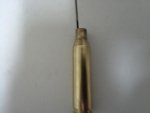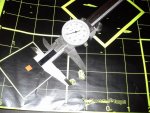After getting my rifle back from the gunsmith I went to range and this is what the brass looked like. The picture isn't that great but there is ring below the shoulder. To me it looks like it is from build up on the reamer. I tool it back to the gunsmith and he polished the chamber to remove the ring. He showed me the brass from where he test fired it and there wasn't a ring. But when I went back to the range the ring was there again. This picture is actually from after the second trip to the range. I took it back a second time and the smith has polished the chamber some more and has said that if the ring returns that the barrel will have to be set back. I know that I will not be able to reuse the brass. But my concern is the barrel at this point. This is my first custom rifle and it is a bit disappointing. I buy a Rock Creek barrel and the gunsmith who is supposed to be good messes it up.
I know that a barrel can be only set back once and essentially cuts the usable life of the barrel in half.
What will the extra space in the chamber from the gunsmith polishing it out do to the case life and accuracy? Since its not exactly a tight chamber anymore.
If the ring is there after this latest round of polishing should I insist on them replacing the barrel?
FYI its a 260 Remington on a 700 action Rock Creek M24 contour
I know that a barrel can be only set back once and essentially cuts the usable life of the barrel in half.
What will the extra space in the chamber from the gunsmith polishing it out do to the case life and accuracy? Since its not exactly a tight chamber anymore.
If the ring is there after this latest round of polishing should I insist on them replacing the barrel?
FYI its a 260 Remington on a 700 action Rock Creek M24 contour



